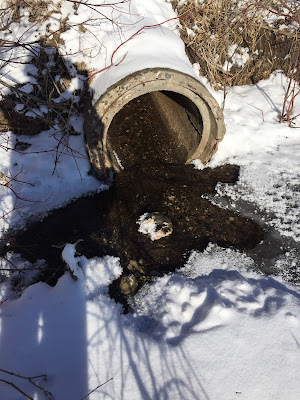The BLID installed an aerator in 2002 after a severe winter
fish kill. The purpose of the aerator is
to oxygenate the water during the winter to ensure that the fish don’t
suffocate from lack of oxygen in the water.
I always thought that shallow lakes would freeze out when
the ice got so thick that there was not enough water left. That was what killed the fish. In researching the aerator, I leaned that the
real cause is lack of sunlight. A high
snowfall winter is actually more dangerous than a cold low snow winter. Here is why.
Birch Lake is weedy. Weeds grow
all year long including the winter. If
the weeds have enough sunlight, they grow and produce oxygen. If the snow and ice get too thick, the
sunlight is blocked. Instead of growing
and creating oxygen, the weeds die, rot, and consume oxygen.
So, how effective can an aerator be if Birch Lake is 100
acres and the aerator keeps less than ¼ acre open and oxygenated? I discussed this with fishing pro and naturalist
Larry Dahlberg, the host of Hunt for Big Fish on the Outdoor Channel.
Larry
explained that the aerator would only save the fish within a certain radius of
the aerator. It would ensure that some
fish survive and be a spawning stock for the fish population to recover - unless
there was a current in the lake. A
current would move the water and carry the oxygen across a larger portion of
the lake.
I always wondered if there were still currents in the
lake. Most of the natural water flow was
cut off when the construction of Highway 96 separated Birch Lake from the water
inflow on the south side. The
construction of North Birch Lake Blvd. cut off the out flow on the north side.
This winter I was able to observe something
interesting. The mild winter and low
snowfall has made it easier to see where currents are be operating. The first thing I noticed is that there is a
line of melting snow that stretches from the culvert on North Birch Lake Blvd.
to the aerator.
Here is an areal view from over the aerator. You can actually see the flow lines.
The flow goes directly to North Birch Lake Blvd. Sure enough, the water was flowing out of the culvert to the Rotary wetlands.
I also noticed that much of the shoreline adjacent to the Rotary Park wetland was full of water. The culvert opening is small in comparison to the volume of water attempting to get out. I began to wonder if the water is flowing out by seeping through the fill of the road.
On my way over to the culvert
I noticed something odd. There is an
in-flow of water from a sping at the Cloisters.
There is a current line from the cloisters to the aerator!
The following picture is taken from the Cloisters facing south toward the aerator.
The last question that came
to mind was why would the flow run through the aerator? The aerator may act as a breather for water
movement. Have you ever poured gas into
your lawnmower without opening the breather on the gas can? The gas does not flow. When you open the breather it clears the
vaacum and lets the gas flow. I think
the opening in the lake caused by the aerator is like a breather. The ice is putting pressure on the lake. The water wants to flow out but can’t. The aerator releases the vacuum and allows
the water to flow.
What do you think?





No comments:
Post a Comment